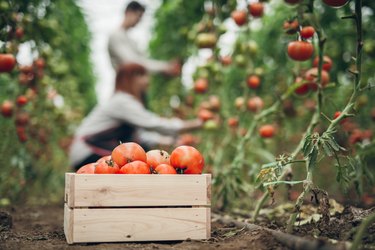
Once a fruit or vegetable is harvested and cut off from its original source of nutrients (plant, vine or tree), that piece of produce begins to lose nutrients, according to the University of California, Davis (UC Davis).
Different processes cause fruit and veggies to start decaying once they're picked, but there are things you can do to get the most nutrient value from your produce. Here's how it happens and what you can do.
Video of the Day
Video of the Day
Respiration
Once they're harvested, fruits and vegetables continue to breathe. This process, called respiration, breaks down stored organic materials, such as carbohydrates, proteins and fats, and leads to a degradation or loss of texture, flavor and nutrients, according to the University of Missouri. Produce releases heat and moisture during respiration, which is one way that fruits and vegetables lose nutrients.
Warm, dry air can speed this process considerably, so keeping produce in a cool and moist environment is beneficial in most cases, per the University of Missouri.
Food that has been picked and transported over long distances is less nutritious than food grown locally because of the time from farm to table, according to Michigan State University.
Most fresh fruits and vegetables are stored in refrigerated conditions, and they can last anywhere from eight to 10 days for highly perishable fruits like berries, to eight to 10 weeks for less-perishable foods like squash, pumpkin, apples, grapes and pears, per UC Davis.
Enzymes and Oxidation
Enzymes — chemicals found in all plants — cause changes in the plants' molecular composition once the food is harvested, which in turn cause spoilage. For example, if you've ever wondered why fruits turn brown when exposed to air, it's because of a process called oxidation, which occurs when the enzymes in it react to oxygen.
The browning and softening of fruits and vegetables are signs that oxidation is occurring and they have lost some of their original nutrient content, according to the Produce for Better Health Foundation. That being said, oxidation takes time, so it's not likely to affect the nutrient content of most fruits all that much. Fruits like avocados are most susceptible to oxidation, but items like avocado savers may help prevent oxygen exposure and preserve them for longer.
Tip
Cutting off the brown part of your fruit and eating the rest is considered safe, per the Produce for Better Health Foundation.
Ripeness
Fruits and vegetables picked when they are ripe may have more nutrients than those picked when they're unripe. But, keep in mind that most produce is harvested when it's close to ripe, according to the Produce for Better Health Foundation.
Specifically, vitamin C increases in fruits and vegetables, such as oranges and tomatoes, as they become more ripe, per the Produce for Better Health Foundation.
But this nutrient is very unstable, and it degrades when exposed to heat, light, water and oxygen. Over time, the vitamin C content in fruit and vegetables decreases rather quickly.
The vitamin C in fresh orange juice was compared to that in reconstituted orange juice over a four- to five-week period in an older 2002 study in the Journal of the American Dietetic Association. The vitamin C in the reconstituted orange juice decreased from 86 milligrams per cup to 39 to 46 milligrams per cup over the study period. The vitamin C in the fresh orange juice decreased from 27-65 milligrams of vitamin C per cup to zero to 25 milligrams per cup.
Finding the Freshest Produce
The Michigan State University Extension recommends choosing produce that is as fresh as possible. If you can't grow your own, look for local farms or growers. The center also notes that buying locally increases the chances of nutritional diversity and decreases the amount of handling, as local produce is commonly picked by hand rather than by machine. Minimal handling means less chance of contamination, which can speed up the spoilage of your fruits and veggies.
- University of Missouri-Kansas City: Transpiration and Respiration of Fruits and Vegetables
- Michigan State University Extension: Eating Local Foods
- Produce for Better Health Foundation: Do fruits and veggies lose nutrients once they pass their point of ripeness?
- Journal of the American Dietetic Association"; Stability of Ascorbic Acid In Commercially Available Orange Juices; C.J. Johnston and D.L. Bowling; April 2002
- University of California - Davis: Maximizing the Nutritional Value of Fruits & Vegetables